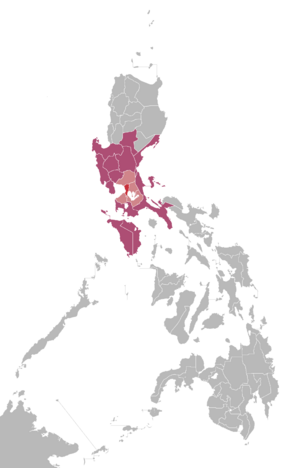DZBB-TV facts for kids
| Metro Manila Philippines |
|
|---|---|
| City | Quezon City |
| Channels | Analog: 7 (VHF) Digital: 15 (UHF) (ISDB-T) (test broadcast) Virtual: 7 (LCN) |
| Branding | GMA TV-7 Manila |
| Slogan | Buong Puso Para Sa Pilipino |
| Programming | |
| Subchannels | See list |
| Affiliations |
|
| Ownership | |
| Owner | GMA Network, Inc. |
|
Sister stations
|
|
| History | |
| Founded | October 29, 1961 |
|
Former call signs
|
None |
|
Former channel number(s)
|
|
|
Call sign meaning
|
DZ Bisig Bayan (named after sister radio station DZBB) or "Uncle BoB" Stewart (founder) |
| Technical information | |
| ERP | Analog: 100 kW TPO (1,000 kW ERP) Digital: 10 kW TPO (100 kW ERP) |
| Transmitter coordinates | 14°40′12″N 121°3′0″E / 14.67000°N 121.05000°E |
| Translator(s) | D-5-ZG 5 Iba, Zambales D-5-ZB 5 Baler, Aurora D13ZR 13 Occ. Mindoro |
| Links | |
| Website | GMANetwork.com |
DZBB-TV, also known as Channel 7, is the main television station of GMA Network in the Philippines. It is owned and run by GMA Network, Inc.. The station's studios are in Quezon City, at the GMA Network Center. Its powerful transmitter is located at the GMA Tower of Power in Quezon City. This station broadcasts 24 hours a day, except during the Paschal Triduum of Holy Week.
Contents
The Story of GMA Channel 7
DZBB-TV's story began with a radio station called DZBB in Metro Manila. This radio station was owned by a company that later became Republic Broadcasting System, Inc.. The company was founded by Robert "Uncle Bob" Stewart.
Starting a TV Station
After the radio station became successful, the company decided to try television. On October 29, 1961, RBS Channel 7 began broadcasting. It was the fifth TV station to open in the Philippines. Other stations like ABS Channel 3 and CBN Channel 9 were already on air.
When it first started, the TV network had only 25 employees. Other stations had around 200 people working for them. RBS Channel 7 used an old transmitter and just two old cameras. They also had no special lights or props for their shows.
Facing Challenges and Finding Success
The station often struggled with money and was almost going out of business. Robert Stewart was about to give up. But then, a dance show called "Dancetime with Chito" became very popular. This brought in a lot of money from advertisements. Also, showing TV programs from the United States helped the station stay successful.
Changes During Martial Law
In 1972, President Ferdinand Marcos declared martial law in the Philippines. This meant the government took control of many things. The station was forced to close down for over three months. It returned to broadcasting in late December of that year. For a while, the government's National Media Production Center (NMPC) helped run the shows.
In 1974, RBS, including its TV and radio stations, was sold. Three people bought it: Felipe Gozon, Gilberto Duavit, Sr., and Menardo Jimenez. The new owners changed the programs to reach a new audience. They bought new equipment and introduced new shows. The station also got a new name: GMA (Greater Manila Area) Radio-Television Arts. In 1979, its new slogan became "Where You Belong."
Returning to Democracy
When democracy came back to the Philippines in 1986, after the People Power Revolution, other TV stations started broadcasting again. The country also faced some political problems. Soldiers even entered the GMA studios for two days during an attempt to overthrow then President Corazon Aquino.
In July 1987, GMA started broadcasting in full stereo sound. This was called GMA StereoVision. It was the first TV station in the Philippines to do this. In 1998, it upgraded to a 100-kilowatt broadcast capacity.
On November 7, 1988, DZBB officially opened its new, powerful transmitter in Quezon City. This transmitter was called the "Tower of Power." It was about 777 feet (237 meters) tall, making it the tallest man-made structure in the country at that time. This tower greatly improved the channel's signal in Luzon.
Digital Television Broadcasting
Digital television is a newer way to broadcast TV signals. It offers clearer pictures and sound.
Digital Channels of DZBB-TV
DZBB-TV's digital signal uses UHF channel 15 (479.143 MHz). It broadcasts several subchannels, which are like different channels within one main signal:
| Channel | Video | Aspect | PSIP Short Name | Programming | Note |
|---|---|---|---|---|---|
| 7.01 | 480i | 4:3 | GMA | GMA (Main DZBB-TV programming) | Commercial broadcast (10 kW) |
| 7.02 | GNTV | GMA News TV | |||
| 7.03 | HEART OF ASIA | Heart of Asia | |||
| 7.04 | HALLYPOP | Hallypop | |||
| 7.05 | (UNNAMED) |
|
Black screen | ||
| 7.06 | |||||
| 7.07 | |||||
| 7.31 | 240p | GMA1SEG | GMA | 1seg broadcast |
In February 2013, GMA Network started testing its digital broadcast. They used the ISDB-T standard, which is a type of digital TV technology. This test was done on UHF channel 27 (551.143 MHz).
By December 2017, the station's improved digital signal reached many areas. These included Metro Manila, Rizal, Cavite, Laguna, Bulacan, and parts of Pampanga, Bataan, Nueva Ecija, and Batangas.
In 2016, the National Telecommunications Commission (NTC) allowed GMA to use UHF channel 15 (479.143 MHz). This was to help expand digital TV broadcasts. On May 15, 2019, GMA Network officially began its digital test broadcast on UHF Channel 15. This is now its permanent digital frequency assigned by the NTC.


